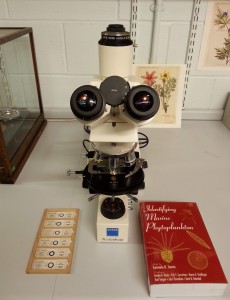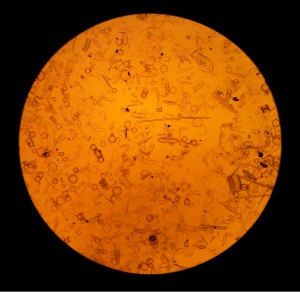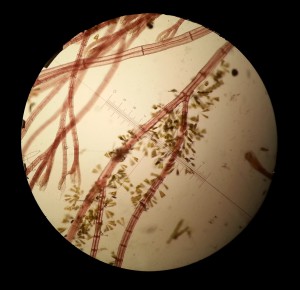
I am a Natural Talent Trainee, and my area of study for the year is in Marine Diatom Taxonomy. “Taxonomy” being a word for a giant game of “spot the difference”, and “Diatom” a word that indicates that this game will be played on a microscopic scale. And so, I introduce you to the tools of my trade!
 Diatoms are important for the health of our Seas; they form the base of the ecosystem as a primary producer or food source. Not surprisingly they also happen to be big hitters in terms of global oxygen production (and carbon sequestration) through photosynthesis. They account for roughly 20%, which is a little more than all the worlds rainforests put together. Another way of looking at it is that for every 5th breath you take, you should spare a thought for the diatoms!
Diatoms are important for the health of our Seas; they form the base of the ecosystem as a primary producer or food source. Not surprisingly they also happen to be big hitters in terms of global oxygen production (and carbon sequestration) through photosynthesis. They account for roughly 20%, which is a little more than all the worlds rainforests put together. Another way of looking at it is that for every 5th breath you take, you should spare a thought for the diatoms!
The marine ecosystem is a fragile one, heavily influenced by anthropogenic activity; from fishing practices to carbon dioxide emissions. And so the marine environment has, quite rightly, become an important area of study. Now, the study of taxonomy is the first, and most important step in understanding an ecosystem; it allows us to define what is there. Without it we’d be in a right mess, struggling to differentiate between a beetle’s arm and a bee’s elbow.
To help me develop the skills I need to begin to understand this seemingly endless variation that lies at the heart of biodiversity, I have returned to my hometown to draw upon the expertise at National Museums Liverpool. I’ve been away for a while and a lot has changed in my absence, we’ve had a makeover. But it’s still the Liverpool I knew, beneath this new glossy surface and I’m very excited to be back.
Not to draw any unsavoury parallels; we have all heard the old adage of judging books by their covers. With Diatoms, you mustn’t be fooled by the disgusting mess they make when they all get together. That slime in the fish tank, the brown slippery film that makes submerged rocks treacherous footing or the goo that aggregates in nooks and crannies of anything you leave in the water too long, all have a hidden beauty. The trick is to get up close – I mean really close – because the beauty is in the detail.
The shapes and intricate patterns that Diatoms produce are phenomenal, it’s difficult to describe. But that’s what these 12 months are all about so I’ll keep you posted!
Find out more about Natural Talent
Find out more about Esmée Fairbairn Foundation
Find out more about World Museum Liverpool


